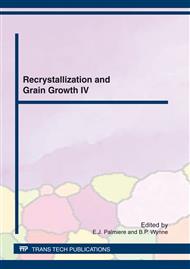p.739
p.745
p.751
p.758
p.764
p.770
p.776
p.782
p.788
Modelling of Particle Pinning in Dual Scale Using Phase Field Method
Abstract:
Modelling the evolution of structures in polycrystalline materials with distributions of fine particles requires integration of multiple length scales. Grain boundaries interact with particles on the scale of the particle diameters. The particle pinning force controls the kinetics of grain growth. Grain diameters can be several orders of magnitude larger than particles. In this work, a methodology is proposed to combine two sets of phase field models at different length scales. At the smaller scale, the effect of particles on movement of a single grain boundary is modelled in a small domain with a high grid resolution. The interface moves in an array of particles with specified shape and size distributions. The average pinning force exerted by the particles, is calculated from the interface velocity. Then, an effective driving force model is developed to incorporate the obtained pinning force into the large scale where grain growth simulations are preformed. In this model, the particle pinning force is subtracted from the driving force in the phase field formulation. In this effective formulation, particles are not resolved in the calculation grid. Therefore, with the larger numerical mesh, modelling of larger systems is possible. Kinetics of grain growth was studied with 2 dimensional simulations. Keywords: Phase field modelling, particle pinning, grain growth
Info:
Periodical:
Pages:
764-769
Citation:
Online since:
April 2012
Authors:
Keywords:
Price:
Сopyright:
© 2012 Trans Tech Publications Ltd. All Rights Reserved
Share:
Citation:


